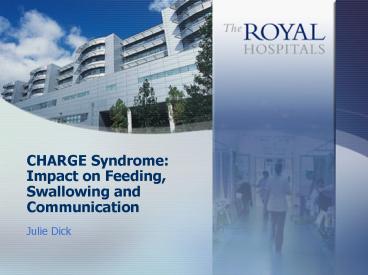CHARGE Syndrome: Impact on Feeding, Swallowing and Communication - PowerPoint PPT Presentation
1 / 19
Title:
CHARGE Syndrome: Impact on Feeding, Swallowing and Communication
Description:
A Atresia choanae. R Retarded growth and development. G Genital Anomalies ... Choanal atresia (2005) (%) Dobbelsteyn et al. Frequency. n = 5. Tracheostomy n-4 ... – PowerPoint PPT presentation
Number of Views:420
Avg rating:3.0/5.0
Title: CHARGE Syndrome: Impact on Feeding, Swallowing and Communication
1
CHARGE Syndrome Impact on Feeding, Swallowing
and Communication
- Julie Dick
2
CHARGE ASSOCIATION
- C Coloboma
- H Heart defects
- A Atresia choanae
- R Retarded growth and development
- G Genital Anomalies
- E Ear anomalies and Deafness
3
CLINICAL OUTCOMES
Feeding
Swallowing
Communication
4
Participants
- From 1999 to 2003, consecutive infants with
CHARGE syndrome - Data from five children (4 male and 1 female)
- 1 month-8 months at in patient referral
- 2-6 years at time of audit study
- Diagnosed by a geneticist
- 2 children in group died at 15 and 12 months
5
Procedure
- Clinical and radiological data
- Jointly reviewed by two Specialist SLTs
- Confidentiality of audit data strictly
maintained. - Clinical features, feeding, swallowing and
communication outcomes - Online Mendelian Inheritance in Man (OMIM) and
Ovid Medline literature searches.
6
Major and Minor Features of CHARGE in this
Audit Population and in the Literature
7
Frequency of feeding related medical conditions
8
Tracheostomy n-4
- All for airway management
- 3 ventilator support
- 3 lt 1 month old at placement
- 1 deceased 12 months
- 1 trache in situ at study
- 2 decannulated aged 2 and 5 years
9
Feeding outcomes tube feeding
- Dobblesteyn et al 2005
- (n-5)
- 2 dependent tubegt4 years old
- 2 successful bottle feeders
- 4 safe with puree by 4 years
- 5 safe cup drinking by 4 years
- Audit Population
- (n-5)
- All dependent tube at 1 year old
- All unsuccessful bottle feeders
- 3 early G- tube placement
- 1 deceased
- 2 aspirate and tube dependent
- 2 early ng-tube placement
- 1 deceased 15 months
- 1 full oral feeding by 16 months
10
Severe subgroup of wider phenotypic spectrum
High Surgical needs
Poor Medical Outcome
High Medical needs
Poor Feeding Outcome
Tube dependency
Cup drinking and puree
High morbidity and mortality
Bottle feeding
11
Swallowing outcomes
- Penetration Aspiration Scale (P/A) (Rosenbek et
al. 1996) - Royal Hospital Dysphagia Risk Score (DRS)
- (Horner 1992 and Logemann 1995)
- duration of swallow delay
- site of the bolus at swallow trigger
- extent of post-swallow residue.
12
Swallowing dysfunction the audit population
13
Prevalence of swallow difficulties reported in
this audit population and the literature
14
Communication Outcomes n-3
- 3 children linguistic period
- All moderate- profound bilateral hearing loss
- None extensive retinal bilateral coloboma
- No microcephaly
- Thelin and Fussner 2005
- Successful amplification
- Independent walking
- Communication training by 3 years
15
Factors related to the development of symbolic
language outcomes
16
Factors related to the development of symbolic
language outcomes
- Intellectual outcome and language development not
influenced by severe neonatal medical history,
poor respiratory status, tracheostomy, tube
feeding and / or cardiac surgery (Raqbi et al.
2003) - Blake et al. 1998 children with CHARGE can excel
once mobility and an effective communication
system are established - 2/ 3 children had total communication programmes,
speaking valves, and auditory rehabilitation
programmes introduced between 6 months and 9
months old - Symbolic language developed with receptive and
expressive delay of 6 18 months and 12 24
months respectively.
17
Aim of the Audit Study
- To enhance acute Speech and Language therapy
care of infants and young children with CHARGE
syndrome by providing a fuller understanding of
feeding, swallowing and communication outcomes
for families and professionals.
18
Clinical practice guidelines
- Clinical feeding evaluation detailing cranial
nerve function - Objective swallowing evaluation
- early investigation and management of
gastroesophageal reflux disease - Speaking valve assessment to optimise
opportunities for active interaction with
environment - Parental communication training programmes
- Total communication programmes
- Cause of death is included in the patient notes
19
Limitations and Future Directions
- Not reflective of the wide spectrum of this
multiple anomaly and multi-sensory condition - Limited by the specificity of the cases
encountered and the duration of our clinical
contact - A multi centred prospective audit and evaluation
with stratified age sampling - voice and vocal cord function for speech and
swallowing in older children































